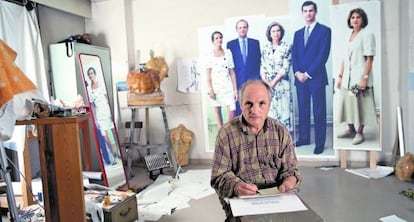Two decades later, painter Antonio López finishes royal family portrait
Life-size work had to be renamed after King Juan Carlos’s surprise abdication earlier this year

More than 20 years after he began it, painter Antonio López has finally completed his portrait of the Spanish royal family. López, noted for his unhurried approach to his work, was putting the finishing touches to the life-size canvas in the Royal Palace in June when the then king, Juan Carlos, announced his abdication in favor of his son Felipe, requiring a name change to the work. Originally to be called simply The Royal Family, the painting is now entitled The Family of Juan Carlos I.
José Luis Díez, the newly appointed curator of the Royal Collections, told EL PAÍS that the work will be unveiled to the public at a major exhibition of portraits of Spanish royalty loaned from the collections, which will be held in late November at the Royal Palace in Madrid.
Díez, one of the few people to have seen the portrait, in which Juan Carlos’ three children, Elena, Cristina and Felipe, are still unmarried, says that it will have been worth the wait. “I was afraid that this might not have come up to scratch, but I can say that this is a very important painting,” he says. Prior to taking up his current post in January, Díez spent 26 years as chief restorer of 19th-century painting at the Prado.
López has said he would like to paint King Felipe and Queen Letizia: “But this time I would be a bit quicker!”
Soon after assuming his new role, Díez began organizing the exhibition, aware of the importance of López’s work in bringing to a close a series of portraits dating back to Isabel the Catholic, as painted by Juan de Flandes (normally hidden from public view in the Royal Palace).
López said recently that he would like to paint King Felipe and Queen Letizia, joking: “But this time I would try to be a bit quicker.” Speaking to EL PAÍS, the painter denied that Juan Carlos’s abdication had put him under pressure to finish the work. “I go every day to the Royal Palace, between 12 and five in the afternoon, without stopping to eat. I do what I can, bearing in mind the difficulties the commission involves. It’s a wonder I haven’t ended up hating the thing,” he said, adding that he had no regrets about accepting the commission, and that Juan Carlos and Sofía had still not seen the work.
The painting portrays the royal family at the height of their popularity, a symbol of Spain’s new democratic age, a time when both the country and the monarchy had much to look forward to. It will go on display in a room alongside the portrait of Juan Carlos I by Salvador Dalí, which was delivered on time in 1979.
After the exhibition closes in April 2015, the canvas will join the Museum of the Royal Collections, due to open in 2016.
Tu suscripción se está usando en otro dispositivo
¿Quieres añadir otro usuario a tu suscripción?
Si continúas leyendo en este dispositivo, no se podrá leer en el otro.
FlechaTu suscripción se está usando en otro dispositivo y solo puedes acceder a EL PAÍS desde un dispositivo a la vez.
Si quieres compartir tu cuenta, cambia tu suscripción a la modalidad Premium, así podrás añadir otro usuario. Cada uno accederá con su propia cuenta de email, lo que os permitirá personalizar vuestra experiencia en EL PAÍS.
¿Tienes una suscripción de empresa? Accede aquí para contratar más cuentas.
En el caso de no saber quién está usando tu cuenta, te recomendamos cambiar tu contraseña aquí.
Si decides continuar compartiendo tu cuenta, este mensaje se mostrará en tu dispositivo y en el de la otra persona que está usando tu cuenta de forma indefinida, afectando a tu experiencia de lectura. Puedes consultar aquí los términos y condiciones de la suscripción digital.
Últimas noticias
The complicated life of Francesca Albanese: A rising figure in Italy but barred from every bank by Trump’s sanctions
How Japan is trying to avert ‘digital defeat’
Pinochet’s victims grapple with José Antonio Kast’s rise in Chile
Reinhard Genzel, Nobel laureate in physics: ‘One-minute videos will never give you the truth’
Most viewed
- Pablo Escobar’s hippos: A serious environmental problem, 40 years on
- Why we lost the habit of sleeping in two segments and how that changed our sense of time
- Trump’s obsession with putting his name on everything is unprecedented in the United States
- Charles Dubouloz, mountaineering star, retires at 36 with a farewell tour inspired by Walter Bonatti
- The Florida Keys tourist paradise is besieged by immigration agents: ‘We’ve never seen anything like this’









































